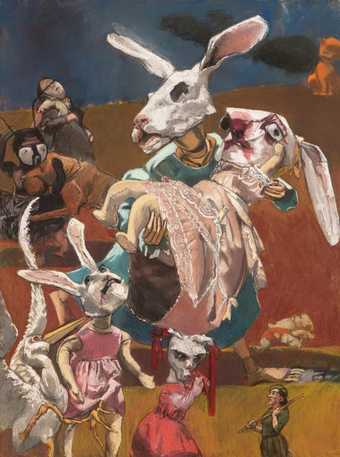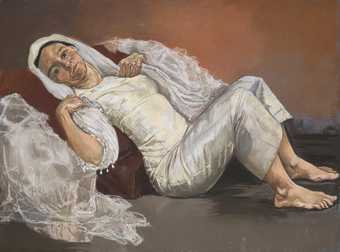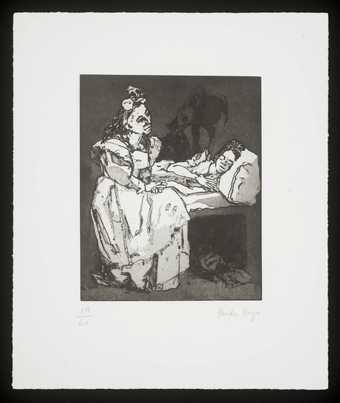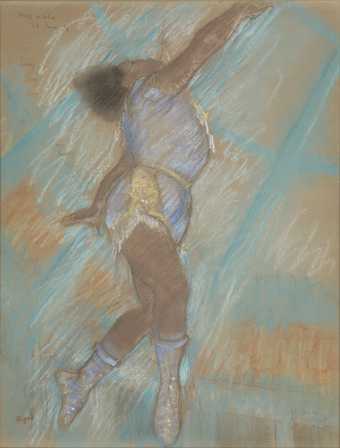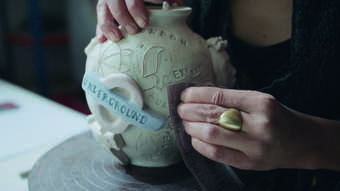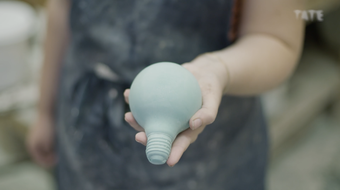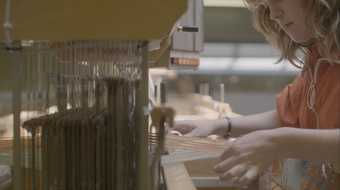Hi, my name is Katy and I’m an artist based in London. Today we’re going to explore how to draw like Paula Rego.
Paula Rego is a Portuguese-born artist, who is known for her paintings and drawings based on folk tales. Her work often reshapes traditional stories to reflect personal experiences, and focuses on female roles within the family.
In 1994, she began to experiment with pastels and has continued to use them ever since. She describes working in pastels ‘like painting with your fingers’.
Rego started drawing when she was four years old, inspired by Walt Disney and the stories her father read to her. The scenes in her pictures almost always take place in domestic settings and are filled with mystery.
When I look at Rego’s work, I feel like I’m seeing a story through her eyes. She makes the story her own, bringing it to life on the page or canvas, with line, colour, and tone.
For this drawing I’m going to take inspiration from Rego’s pastel work Bride. It's part of a series of drawings called Dog Woman.
To draw like Paula Rego, you will need: a drawing board and an easel, pastel paper, hard pastels, soft pastels, conte pencils, white liquitex gesso and black or dark grey acrylic paint, fixative, masking tape and a selection of props.
When beginning an artwork, Rego makes a series of imaginative drawings, testing out her ideas and playing with possibilities. Rego always works from life and never uses photographs. For my picture, I’m going to draw a scene from The True Bride. The German fairy tale is fantastical and dark.
Before you start your drawing, you need to prepare your pastel paper. Mix a spoonful of white gesso with a small amount of black or dark grey acrylic paint. Then apply an even coat using a wide paintbrush.
While the paper is drying, I’m going to do some quick studies of the scene in front of me. So with this drawing I am trying to understand the pose, getting a sense of how the pose relates to the story.
For your next sketch, do a study that establishes the composition. This helps map out exactly what you want to include in the final image. I find it helpful to draw with my eyes unfocused. It helps me to see large areas of light and dark.
I have used these two drawings to establish my composition, so now I am ready to start on my larger drawing.
Paula Rego tends to work on paper fixed on canvas or a board on an easel. To start, I use the hard pastels and brown and black conte pencils to draw an outline of the overall scene. I think it’s better to not get too hung up on the details. Especially at the beginning of a drawing. Don’t worry about making mistakes. Rego often makes changes to her drawings as she goes. She once said, ‘invention comes when you do a drawing. As you are drawing something, it very often turns into something else, and you can go with it.’
I have chosen a range of warm, muted colours to reflect the palette Rego uses in Bride. Rather than mixing the pastels, Rego applies a layer of fixative between each stage of her drawing. This technique enables her to build up layers of colour. It’s best to spray the fixative in an open-air space.
Once you’ve got the rough outline of your drawing, you can start adding colour to the image. And as you go thinking about the tone, and the details of the scene in front of you. You should do this using soft pastels. The softer the better.
When discussing why she started using pastels rather than paint, Rego said that pastels allow you to draw around and within the figure, whereas painting is just ‘filling in’.
Rego has spoken about expressing her fears and fantasies within her artwork, saying ‘The picture allows you to feel all sorts of forbidden things.’ Why not try letting your imagination take over whilst you’re drawing?
It's time to add another layer of fixative.
Paula Rego uses pastels in a very particular way. She starts off using harder pastels, and then works over the top of them with softer ones. Rego said she prefers hard pastels because they give you a resistance and you can push and scratch into the surface with them.
Rego’s figures are solid. They feel very alive. This comes from her close observation of the model, using pastels to bring a three-dimensional figure to life on a two-dimensional surface.
One more fix.
At this stage I am scratching into the surface of the thick layers of pastel with the hard conte pencil. This adds texture to the surface and also scratches through to the different layers of colour underneath. Paula Rego likes to do this as part of her process of layering up lots of layers of pastel.
When you’ve finished your drawing, step back and see if any areas need more work. It's important to look at the image as a whole. Think about the boundaries of your drawing, and work right up to the edges of the page.
There you go. That was how to draw like Paula Rego.

